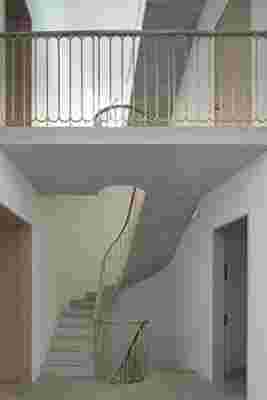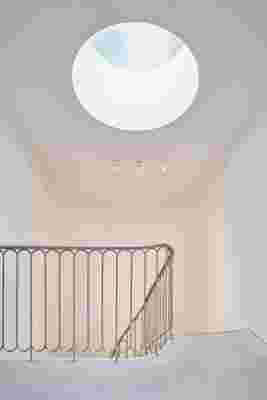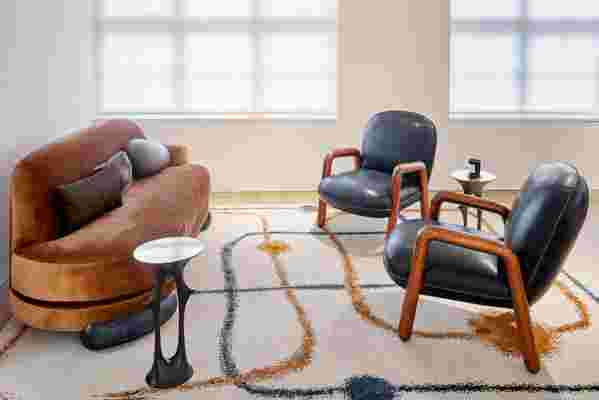For art collector Alexander V. Petalas, the two most fretted details of designing a space to exhibit one’s collection—namely, the building and the architect—were no-brainers. “The day we found the building was the last day to put in offers,” recalls Petalas. “There were hardly a few hours between thoughts of ‘I can’t do this’ and signing the papers—it just happened really naturally.”
When the Swiss-born Greek collector speaks of the short history of The Perimeter, his private art space and office founded hardly a year ago, he exudes an easygoing calm. Dressed in a nondescript blue sweater, jeans, and black socks, and sporting a thick mop of jet-black hair, Petalas, 38, is the complementary second half to the converted warehouse: Its scintillating interior was gutted and redesigned by London-based gallery specialists 6a Architects in their characteristic light as a feather touch. Just like its owner, The Perimeter harbors a set-in-stone tranquility, elegant without tending toward excess or restraint.
Flanked by architecture offices, a piano store, the Charles Dickens Museum, and pubs galore, The Perimeter occupies an unexpectedly quiet nook of Bloomsbury—a rare respite from buzzy central London. The three-floor, 19th-century converted warehouse was once home to a band of craftspeople—metal workshops, timber yards, and print studios among others—and, as a result, was divvied up into several separate units over the years. The architect’s first move was to reunite the space into one coherent structure and open it back up to the outside world with generous windows on the ground floor. Gutting the interiors enabled 6a Architects to reorient the core of the building around its spinelike sinuous staircase, which stretches across five floors (three above ground, two below).

The building was once home to a metal workshop, timber yard, and print studios, among others.
Comprised of pale concrete, dyed ash handrails, and a nickel-silver balustrade designed by Petalas himself, the apparently weightless structure leaps from the double-height entrance hall, guided upward by a circular skylight framing the gallery’s pitched roof. It’s a fitting feature for The Perimeter’s welcoming artwork: A heavenly choir greets visitors when the front door swings open on command (Titled The Calling , it is a piece by sound sculptor and Turner Prize–winning artist, Susan Philipsz).
“I’m in the space every day, so it was important to me that it felt very personal, very much like home,” reflects Petalas. As one spends time at The Perimeter, more of its domestic undertones bubble up from the radiant backdrop. Little details, like the painted brick alcoves left unplastered on each floor—original architectural features dating back to the building’s beginning—alongside warm wooden floors in the large gallery on the second floor succeed in distinguishing The Perimeter from your typical white cube. In Petalas's office on the top floor of the building, a velvet couch couples with a solid acrylic table beneath a rich blue Carmen Herrera painting to create a space that’s both homey and sophisticated.

A circular skylight framing the gallery’s roof adds to the ethereal ambience in the space.
There are moments where Petalas’s unique humor shines through his diverse collection, such as the piece by London-born artist Prem Sahib installed in the ground floor bathroom. A backlit window flecked green with silhouetted leaves makes one’s visit to the restroom an exercise in teleportation, as if being whisked away into a verdant country manor on a summer's day. And while permanently housed in the archive, Petalas’s collection of Starbucks city mugs, now in the hundreds, cannot be left out of the conversation. “It’s a game I play with friends and family,” grins the jet-setting collector. “I can only purchase mugs from cities I’ve been to. Online auctions are a slippery slope.”
The ideal backdrop for Petalas’s dynamic collection, which includes work by Martin Creed, Phyllida Barlow, Wolfgang Tillmans, and Laura Owens, as well as members of the new avant-garde like Martine Syms, The Perimeter’s understated elegance also belies just how hard the building, and the architects, have worked to conjure its trademark grace.

Inside the gallery.
Trippy candy-color paintings by Brooklyn-based painter Emily Mae Smith and mesmerizing concentric ceramics by Taiwanese artist Chun Liao are among the works in Petalas’s prolific collection—which features an estimated 200 artists, nurtured by the advice of notable gallerists and friends Stuart Shave of Modern Art and Sadie Coles—not currently on show. A long white table laden with flowers runs alongside the storage and is visible from the entrance hall. “It was important that every room looks out onto another, to establish an immediate sense of connection intrinsically within the building,” explains Petalas.
The ultimate resource for design industry professionals, brought to you by the editors of Architectural Digest
All of the electronics, cabling, and temperature management systems for the gallery are stowed one floor below, thanks to a costly excavation process carried out by 6a Architects. An architect-designed mews warehouse conversion is hardly a rarity in London’s affluent West End, but The Perimeter sets itself apart through its elevation of contemporary art and the relative openness with which it greets the rest of the city. Visitors can visit any Tuesday - Friday, 11am-5pm, with booking via the website . A rotating exhibition cycle means that fresh work from the collection is always on offer, and Petalas does his part to support the work of younger emerging artists as much as the bigger names. As The Perimeter opens its doors for the previously unsung American ceramicist Ron Nagle, Petalas presents a taste in contemporary art that’s as charismatic and distinctive as the architecture.
